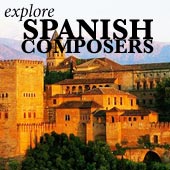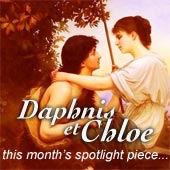Beethoven Pastoral Symphony (6th)
A Love of Nature
The 'Pastoral Symphony' (Beethoven's 6th symphony) is a charming masterpiece, which both paints a picture of nature and describes man's feelings towards it.

Beethoven loved the natural world, and was inspired to write this symphony by his regular walks in the countryside around Vienna.
"How happy I am to be able to walk among the shrubs, the trees, the woods, the grass and the rocks! For the woods, the trees and the rocks give man the resonance he needs."
The pastoral (rural) theme in music had been going on for centuries before Beethoven. There had been lots of pieces describing shepherds, storms, the singing of birds, and other boringly quaint little scenes.
But the Pastoral symphony doesn't just tell a story. Beethoven was the first to express, alongside the images of nature and smiling peasants, the mixture of feelings people have when they go to the countryside.
"Recollection of Country Life" he wrote on the title page, and below that, "more an expression of feeling than a painting". However, the symphony does in fact contain a fair amount of images of nature as well...
Beethoven began sketching out his symphony number 6 in 1802, and finished it in 1808.
The premiere was probably the grandest musical event in Beethoven's life. It was a massive concert, packed with four and a half hours of brand new Beethoven music! Apart from the Pastoral, there was also the Fifth symphony and a new piano concerto. What a lucky audience!!
But it wasn't exactly a great concert. The audience was bored - it was almost a case of too much of a good thing. The auditorium was also freezing, and the orchestra played rather badly from not having time to rehearse.
So the Pastoral symphony didn't really have a great start. But not to worry! It soon became a popular favorite, and still is these days.
Music

Beethovens 6th Symphony is packed with rustic sounds, simple folk tunes, lots of repetition (instead of development), and a feeling of calm beauty.
But the music also contains an emotional aspect, which reflects mankind's feelings towards the natural world.
Beethoven spread the symphony out into five movements, and gave each movement a little subtitle explaining what it was about.
- Allegro, "Awakening of cheerful feelings upon arrival in the country": just as the title says. The Pastoral symphony opens with warmth and calm, setting the scene as we arrive in the countryside:
- Andante, "Scene at the stream": This slow movement is a beautiful depiction of the delicate nature of... nature itself. You can almost breath the fresh country air! Towards the end we hear some bird sounds.
- Allegro, "Happy gathering of country folk": Now we turn our attention to the loud, jolly peasants who live in the countryside. Here we see (or hear) them celebrate with a joyful dance. Of course, these are simple folk, so the music itself is simple (but extremely energetic):
- Allegro, "Thunderstorm": With no pause between this movement and last, there's a dramatic surprise, hinting at trouble ahead:
Yes, a storm is brewing! Beethoven inserts fantastic lightning crashes and the whirl of the wind.
But there's more in this movement than the noise and energy. There's an underlying sense of human fear, since humanity is powerless against the forces of nature. - Allegretto, "Feelings of joy and gratitude after the Storm": As the storm fades away, all the animals emerge, and there's a general feeling of relief. This is a calm movement, full of grace. It starts out quiet and beautifully:
...but quickly gets faster and happier. The music is fairly simple, but this makes its emotions of gratitude endearing. And so the Pastoral Symphony ends!
Recordings
There are ridiculous amounts of performances of the pastoral symphony, since there is of course one in every interpretation of the 9 Beethoven symphonies.
A good place to start is the recording by George Solti, conducting the Chicago Symphony Orchestra. It was recorded in the late 80s, and has a big and spacious sound. Solti lets the music breath freely, basically speak for itself. Available on Decca.
But the huge favorite recording of the Pastoral symphony is from 1958. Leading is conductor Bruno Walter, who actually had as his orchestra a random jumble of freelance musicians. But did it ever work!
For decades this has been held up as the recording of the 6th. It's simply as close to musical perfection as can be achieved. It suffers slightly from old recording technology, but the interpretation still shines through. Available on Sony.
Other great Beethoven symphonies...
If you like my site, please click "Like"... thanks!



